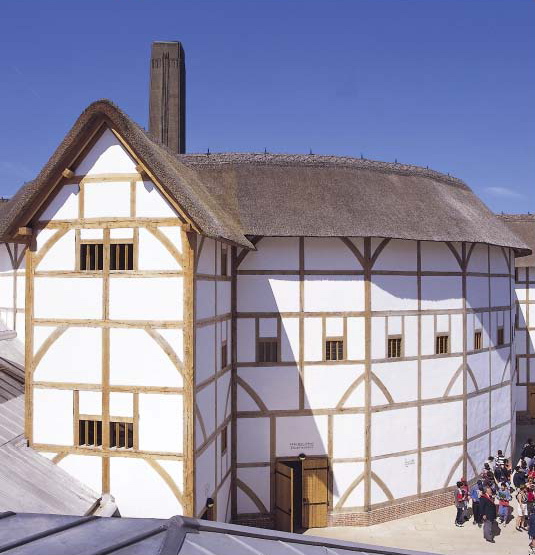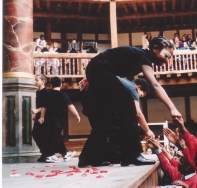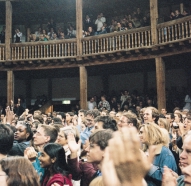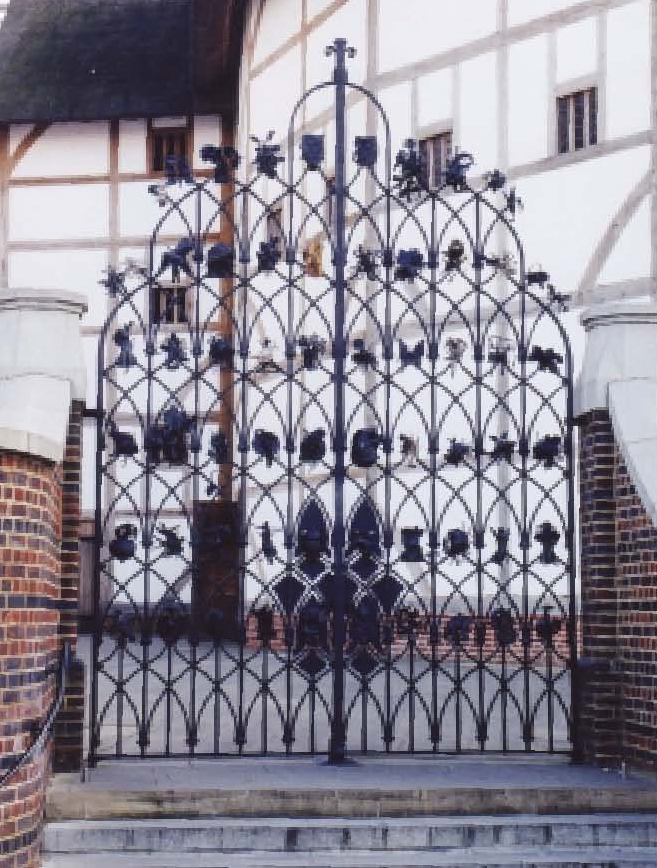Shakespeare's Globe Theatre

The First Globe

The original Globe was built for the Chamberlain’s Men, William Shakespeare’s company of players, in Bankside on the South side of the Thames in 1599. Many of Shakespeare’s greatest plays were performed in the Globe and for 14 years it was one of the most successful playhouses in London.
In 1613 a stage cannon set fire to the thatched roof of the Globe during a performance of Henry VIII and the theatre burned to the ground. A second Globe was built on the same site. Shakespeare may have acted in the second Globe, but he probably never wrote for it. However, it remained a home for Shakespeare’s company until the closure of all theatres by England’s Puritan administration in 1642. No longer of use, it was demolished to make room for tenements in 1644.
What did the first Globe look like? Nobody knows for sure because no plans or construction drawings that clearly depict the form of the original theatre have survived. Printed panoramas, such as those by John Norden and Wenceslaus Hollar, give a rather generalised idea of the theatre’s exterior; written accounts, usually by visitors from overseas, a building contract and one drawing (of the nearby Swan Theatre) tell us something about the interior. In addition, descriptive passages may be found within the plays themselves, such as the famous Chorus at the opening of Henry V:
The Shakespeare Globe Trust

The project to rebuild Shakespeare’s Globe was initiated by the American actor, director and producer Sam Wanamaker. During a visit to London in 1949 he was disappointed to find that the only memorial to Shakespeare at the site of the Globe was a plaque on a brewery wall.
In 1970 he founded what was to become The Shakespeare Globe Trust, whose mission was to reconstruct the theatre and to create an education centre and permanent exhibition dedicated to the exploration of Shakespeare in performance.
After 23 years of tireless fundraising on behalf of the trust, Sam Wanamaker died, the building site having been secured, the exhibition undercroft structurally complete and a few timber bays of the Globe in place. In 1997, three and a half years after Sam’s death, the theatre and its ancillary buildings were completed.
Reconstructing the Globe

Theo Crosby RA, a founding partner of the design company Pentagram, was the architect of the reconstructed Globe, drawing up numerous plans for the theatre from the time of his first involvement with Sam Wanamaker in 1969. Sadly, he died only a few months after Sam, and did not live to see the theatre completed. His work was carried on by the Globe’s current architect, Jon Greenfield.
Techniques used in the reconstruction of the theatre were painstakingly accurate. ‘Green’ oak was cut and fashioned according to 16th century practice and assembled in two-dimensional bays on the Bankside site; oak laths and staves support lime plaster mixed according to a contemporary recipe and the walls are covered in a white lime wash. The roof is made of water reed thatch, based on samples found during the excavation of the site of the original Globe.
The stage is the most conjectural aspect of the reconstruction. Almost nothing survives from the period to suggest the appearance of this part of the theatre. Its design was drawn from evidence provided by surviving buildings of the period and practical advice offered by the actors who participated in the 1995 ‘Workshop’ and 1996 ‘Prologue’ seasons.
The new Globe is also designed with the 21st century in mind. An additional exit, illuminated signage, fire-retardant materials and some modern backstage machinery are all concessions to our times.
The reconstruction is as faithful to the original as modern scholarship and traditional craftsmanship can make it, but for the time being this Globe is - and is likely to remain neither more nor less than the ‘best guess’ at Shakespeare’s theatre.
Globe Theatre Company

Theatre
The reconstructed Globe Theatre sits at the heart of The International Shakespeare Globe Centre Ltd., which embraces three distinct but interdependent activities: performance, education and exhibition.
The Globe Theatre Company is formed annually in the spring, and contracts extend until the end of the theatre season. Several actors have performed in more than one season at the Globe. The company plays in repertory from May to September annually and has gained an international reputation for performance excellence in architectural conditions which are as close as possible to those of Shakespeare’s time. In 2003 the company’s production of Twelfth Night was the recipient of the Critics’ Circle award, a Time Out award and an Olivier award. In 2003 Mark Rylance also accepted an Evening Standard Special Award on behalf of Shakespeare’s Globe.
Mark Rylance was appointed Artistic Director in January 1996. He has appeared in a number of celebrated productions at the Globe, including Henry V, Antony and Cleopatra, Hamlet, Cymbeline and Twelfth Night. In 2003 he played the title role in an original practices production of Richard II. Other regular members of the Globe Theatre’s production team include Greg Ripley-Duggan, Executive Producer; Claire van Kampen, Director of Theatre Music; Jenny Tiramani, Associate Designer; Giles Block, Master of the Words; Glynn MacDonald, Master of Movement and Stewart Pearce, Master of Voice.

Actor, audience and architecture
The relationship between actors and audiences at the Globe is remarkably intimate and informal. The theatre has a capacity of 1,600 people per performance. Approximately a quarter of a million people visit the Globe during the annual performance season. Up to 600 ‘groundlings’ can stand in the yard for each performance and some 75,000 people pay just £5 for a groundling ticket every year.

Original practices
The Globe Theatre Company makes no claim to authenticity in its productions. Many of the conditions of 16th and 17th century performance - the Elizabethan repertory system, 16th century rehearsal practices, pronunciation, the mentality of the audience itself - are, for the time being at least, practicably irrecoverable. Nevertheless, each season’s plays include ‘original practices’ productions that adopt some of the conditions under which the plays could have been first performed. This is most clearly the case in the adoption of all-male casting, recreated clothing, music and dance.

New plays
The theatre has also demonstrated a commitment to the commissioning of new verse drama, having presented Augustine’s Oak (1999) and The Golden Ass (2002), both written by Peter Oswald.
International touring
The Globe Theatre Company has taken a number of its productions abroad. The Two Gentlemen of Verona visited the Theatre for a New Audience in New York in 1996. In 1998 As You Like It toured to the Tokyo Globe, and King Lear visited the same venue in 2001. The 16th century Teatro Olimpico in Vincenza, Italy, has also played host to two Globe Theatre Company productions: Hamlet in 2000 and Macbeth in 2001, while the Brooklyn Academy of Music in New York was the venue for a tour of Cymbeline in 2002. In Autumn 2003, the Globe Theatre Company’s award-winning production of Twelfth Night toured the USA, playing in Los Angeles, Minneapolis, Pittsburgh, Ann Arbor and Chicago.
The International Artistic Residence
The International Artistic Residence for professional theatre artists aims to engage with the international theatre community by sharing the discoveries and learning of the Globe’s theatre seasons. It brings together, via affiliated Shakespeare Globe Centres (see page 9), actors from different creative traditions. The residence introduces the playing space of the Globe Theatre to artists seeking to extend their experience of the work of Shakespeare and his contemporaries.
Globe-to-Globe
Globe-to-Globe is the Globe’s partnership with international theatre and forms part of its mission to explore the impact of Shakespeare on other cultures and investigate how differing social, cultural and political influences find expression through the plays.

Shakespeare's Globe Exhibition
‘Let us on your imaginary forces work’
Shakespeare’s Globe Exhibition offers visitors an introduction to the theatre of Shakespeare’s time and the London in which he lived and worked. Against the historic backdrop of Elizabethan and Jacobean Bankside, it focuses on the actor, architecture and audience, and appeals to the widest spectrum of visitors. It is the world’s only permanent exhibition dedicated to Shakespeare’s theatrical career, and it receives over 300,000 visitors a year.
Sam and the Globe
Sam Wanamaker’s epic struggle to recreate the famous theatre for which Shakespeare wrote many of his works is documented in visual panels and film commentaries by those who worked with him. The reconstruction of the Globe by craftspeople using hand tools and Elizabethan techniques forms part of this remarkable tale.
Costumes, special effects and music
The costume collection demonstrates the process of designing, creating and fitting clothing for Shakespeare’s stage. What did Shakespeare’s company use for blood and gore? How were characters hanged on stage? Elizabethan special effects are brought to life on touch screens. Music played an important part in Shakespeare’s theatre and the exhibition offers the opportunity to see and hear the sort of musical instruments that were used to accompany the plays.
Stage and page
Visitors can join the cast and add their voices to a prerecorded scene performed by Globe actors. There is also a recreation of a 17th century printing press similar to that which printed quarto and folio editions of the plays of Shakespeare and his contemporaries.
Shakespeare’s London
Elizabethan Bankside, the home to the Globe Theatre, is vividly brought to life as an area of brothels, bear-baiting and theatres - the background against which the actors and playwrights of 16th and 17th century Southwark worked.
Visiting Shakespeare’s Globe Exhibition
A visit to the exhibition includes a guided tour of today’s working theatre. From May to September, during matinee performances, the public can visit Bankside’s first theatre, the Rose, and take a ‘virtual tour’ of the Globe Theatre.
